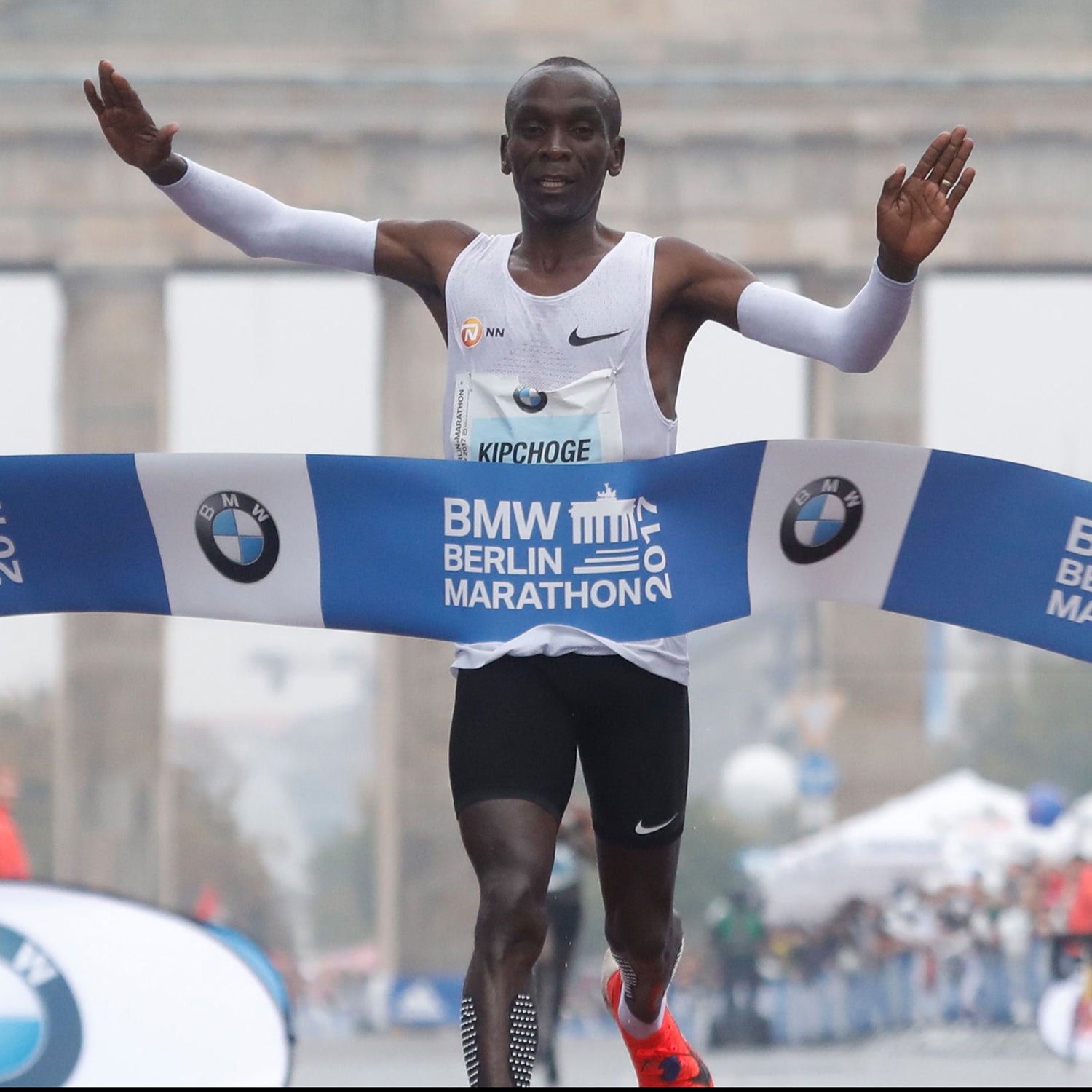Here’s how crazy the hype was leading up to the Berlin Marathon a few weeks ago: bookies were offering in favor of a men’s world record, implying a probability of greater than 60 percent. When calling a coin toss is considered more of a long shot than rewriting the record books, you know something is up.
Then came race day: steady drizzle, 90 percent humidity, and relatively warm temperatures reaching the 60s. Given the conditions, Dennis Kimetto’s 2014 record of 2:02:57 was off the table from the start, though Eliud Kipchoge’s winning time of 2:03:32 still ended up being the seventh-fastest performance in history.
In the aftermath, there were two schools of thought. One was that the record would have been history if the weather cooperated. The other, by former Boston Marathon champ Amby Burfoot, was that “we should return to some commonsense talk about marathon world records.” Expectations became wildly inflated after Kipchoge’s impressive but artificially aided 2:00:25 performance in Nike’s Breaking2 event, Burfoot argued. The current record is very, very fast, and no one—including bookmakers—should “expect” it to fall on any given day.
Given that I’d written a in the New York Times predicting a sub-2:02 for Kipchoge, I felt a little silly reading Amby’s postmortem. Had I totally lost sight of reality? In a subsequent email conversation with Amby and a few other friends, I argued that marathon records are a special case compared to shorter track events. Top marathoners get only a couple chances a year to race, and those rare opportunities can easily be derailed by injury during the buildup, bad weather, or erratic pacing during the race itself. In comparison, a sprinter or middle-distance runner can race week after week during an extended peak, offering a greater chance of hitting a day when all the stars align. Back in 1997, for example, Wilson Kipketer whittled down the 800-meter world record three times in less than two months. As a result of this difference, I claimed, marathon records should have a little more “fat on the bone.” No matter how good a miler is, you’d never expect a record on demand. But in the marathon, with a runner like Kipchoge lining up against all-time greats like Kenenisa Bekele and Wilson Kipsang, maybe it’s not so crazy.
Amby listened patiently to my argument, and then replied: “That should be testable.”
He’s right. If there’s a difference in how easily records at different distances fall, it should show up in the relative frequency of new records. It’s not obvious what the telltale pattern should look like, though. If you start from scratch, you might expect shorter events initially to have more frequent records, since they’re contested more frequently. As time passes, though, you’d expect those shorter events to approach the current limits of runners, and records would become less frequent.
The marathon, in contrast, should initially have relatively infrequent records. But since it’s harder to get everything perfect, marathon records should keep dropping rather than becoming less frequent.
So, drawing on the 2015 edition of , I decided to take a look at how records actually progress. Here’s a plot showing a running tally of records per ten-year period for a selection of men’s events, starting in 1912, the beginning of the IAAF era:
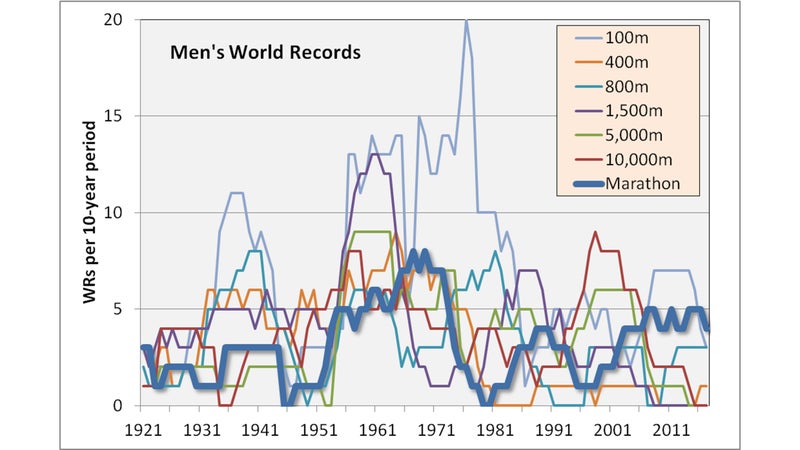
There’s a lot going on here. If you look at the marathon line, the first value, in 1921, is three. That means there were three marathon records in the ten years from 1912 to 1921. The last value is four, meaning there were four records between 2008 and 2017. Between those two points, there are lots of peaks and valleys with no obvious pattern.
There are certainly some global trends across all events. Not surprisingly, the number of records drops during the two world wars and rises between them. The 1950s see a huge surge in records across all events—a reminder that Roger Bannister’s sub-four mile, in 1954, was very much a product of the postwar surge in prosperity and interest in sport. Then things settle back into a somewhat more stable pattern starting in the 1980s and persisting to the present.
The one event that looks like a complete outlier is the 100 meters. That’s because, prior to the introduction of electronic timing, it was very common for the world record to be tied. There were nine world records in 1956 alone (all 10.2 or 10.1), and another eight in 1968 (all 10.0 or 9.9). That makes comparisons with this event not particularly meaningful.
If you pull out the 400 meters (which is long enough to avoid ties) and compare it head-to-head with the marathon, this is what you get for the number of world records in each decade:
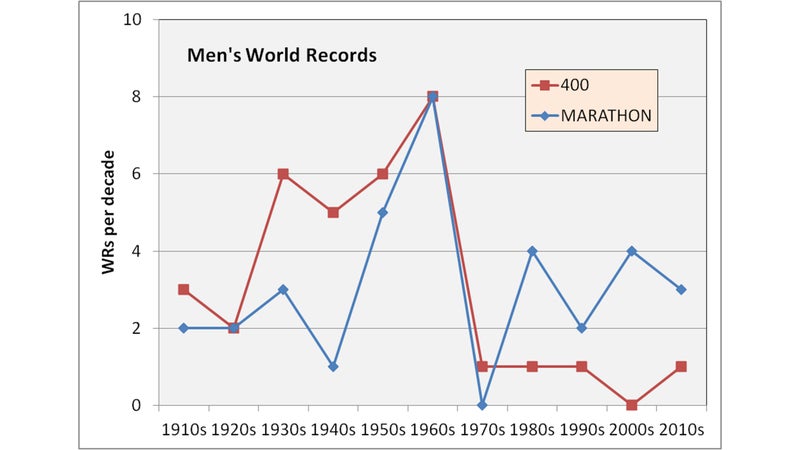
You could argue that this graph sort of agrees with my hypothesis: more records for the shorter event in the early years, more records in the marathon in recent years. But that’s cherry-picking, and the picture is distorted by specific events like Lee Evans’ at the Mexico City Olympics in 1968, as well as Derek Clayton’s marathon in 1969.
The same trends should, in theory, show up in women’s records. The problem is that women have only been officially allowed to compete in marathons for a relatively short period of time, so there isn’t the same long baseline of data. Here’s the comparable 400 meters versus marathon comparison for women, starting in the 1960s:
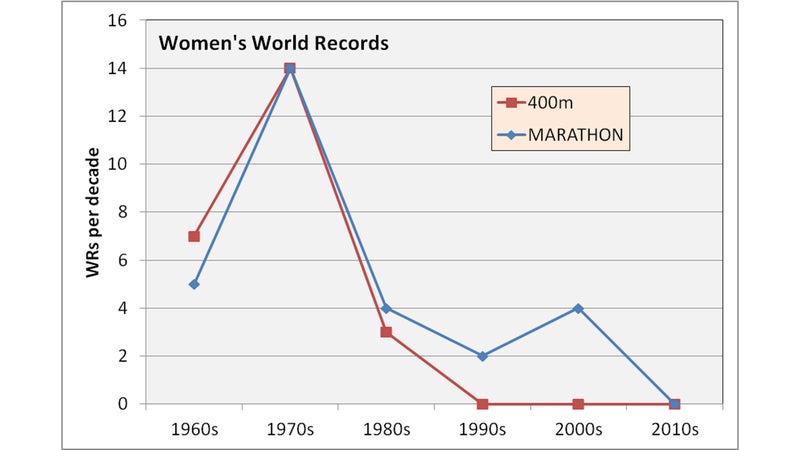
It’s clear in both events that the 1970s were an exciting time in women’s sports, producing a surge in world records that hasn’t been matched since, and likely never will be. In the 400 meters, we haven’t seen a record since 1985, during the peak steroid era. The marathon record, Paula Radcliffe’s 2:15:25, dates back to 2003 and remains bafflingly far ahead of the second-fastest performance of all time, Mary Keitany’s 2:17:01 in London earlier this year. For reasons that aren’t clear, whatever is driving the recent progress in the men’s marathon record (for example, an increase in road-racing prize money) doesn’t seem to be doing the same for women.
To get away from the effects of individual records, it makes sense to zoom out and look for bigger-picture trends. Here’s the total number of men’s records (expressed as “records per decade”) from prior to 1950, 1950 to 1999, and since 2000:
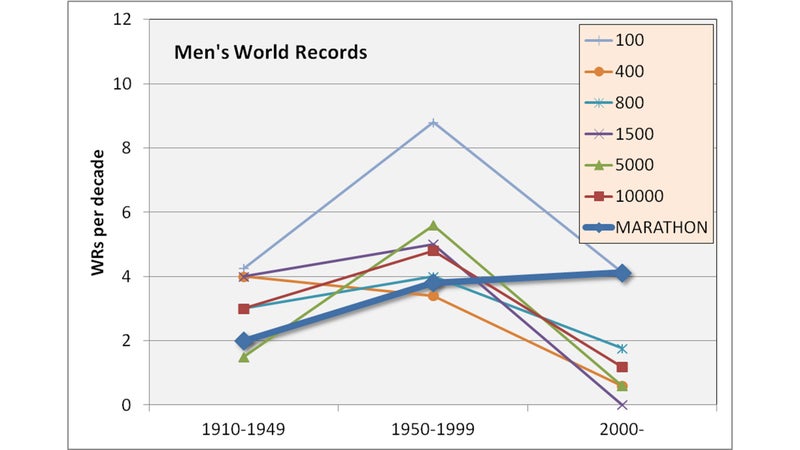
Virtually all events follow a similar pattern: a medium record frequency in the early years, rising to a high record frequency in the second period, dropping to a low frequency since the turn of the 21st century.
There are two exceptions to the pattern. One is the 400 meters, where records were slightly less common from 1950 to 1999 than prior to 1950—perhaps a result, again, of Evans’ Mexico City time. The other is the marathon, which is the only event where records are more frequent this century than they were in either period last century.
So is this vindication of my view that the marathon record is ripe for the taking? “I buy the conclusion that there’s more room for improvement in the marathon than many other events,” Amby said when I showed him the results. The most likely explanations: an influx of talent to the event thanks to increased prize money (coinciding with a for distance runners on the track), along with better shoes.
��
Still, Amby doesn’t expect any big drops in the record. Kipchoge is no more talented than previous once-in-a-generation stars like Haile Gebrselassie, he says—and whenever anyone has tried to run the first half of a marathon anywhere near 61 minutes, even in seemingly perfect condition, the result has been carnage.
Bottom line? The stats bear out my feeling that the marathon record has been uniquely prone to falling lately. There have been an astonishing nine men’s marathon records in the past 20 years. But that doesn’t mean the trend will continue. And in the end, my bold (but failed) prediction of a record in Berlin last month wasn’t based on statistics. It was based on my belief that Eliud Kipchoge, in the wake of his Breaking2 triumph, was physically fitter and mentally stronger than any marathoner in history. Let’s hope he can find that form one more time next spring—and that the weather cooperates.
Discuss this post on or , sign up for the Sweat Science , and check out my forthcoming book, .


